Smith and Wesson 686 Plus Stainless/Wood .357 Mag / .38 SPL +P 3″ Barrel 7-Rounds For Sale
$850.99
The Smith & Wesson 686 Plus is a highly regarded revolver celebrated for its durability, precision, and elegant design. Constructed with a robust stainless steel frame, barrel, and cylinder, it provides exceptional resistance to corrosion and wear, making it suitable for extensive use in both law enforcement and hunting. The revolver features a polished finish and classic wooden grips, exuding elegance while maintaining ruggedness. Its 3-inch barrel ensures accuracy, and the 7-round cylinder accommodates both .357 Magnum and .38 Special +P cartridges, catering to diverse shooting preferences. Safety features include an integrated internal lock and cylinder release button, reducing accidental discharge risks. Weighing 33.5 ounces, it offers comfortable handling with a medium-sized frame and spurred hammer, functional in both single and double action modes. With fixed sights for straightforward targeting, the 686 Plus is ideal for self-defense, target practice, or recreational shooting. Purchase yours today from GrabAGun, a trusted online retailer, to experience its excellence and reliability.
What is the difference between 686 and 686+?
The difference between 686 and 686+ is 686+. The “+” typically indicates an addition or an enhancement, suggesting that 686+ may refer to something slightly different or improved compared to 686. If considering numerical value alone, the difference would be in their symbolic representation rather than a specific numerical difference, since there isn’t a direct arithmetic difference.
What makes the S&,W 686 Plus so popular?
The Smith & Wesson 686 Plus is popular for several reasons:
1. **Quality and Reliability**: Smith & Wesson is known for producing high-quality firearms, and the 686 Plus maintains this reputation. It is reliable and durable, making it a trusted choice for many enthusiasts.
2. **Seven-Round Capacity**: Unlike the standard 686, the 686 Plus features a seven-round cylinder, providing an extra shot compared to the traditional six-round revolvers. This is particularly appealing for self-defense and range use.
3. **Versatility**: The 686 Plus is chambered in .357 Magnum, which allows users to also shoot .38 Special ammunition. This versatility makes it suitable for both target practice and more serious applications.
4. **Ergonomics and Design**: The revolver has a comfortable grip and a well-designed frame that enhances handling. Its weight and balance contribute to manageable recoil, even with powerful .357 Magnum loads.
5. **Accuracy**: It is known for its accuracy, aided by a well-machined barrel, quality sights, and smooth trigger pull, making it a favorite for target shooting.
6. **Aesthetics**: The 686 Plus has a classic and appealing stainless steel finish, which is both attractive and resistant to environmental wear and tear.
7. **Collector’s Appeal**: Being a part of Smith & Wesson’s distinguished line of revolvers, it holds value as a collectible item for firearm enthusiasts.
These factors, along with Smith & Wesson’s solid reputation and customer support, contribute to the 686 Plus’s popularity among both new and experienced shooters.
What are some common problems with the 686 Plus?
The Smith & Wesson 686 Plus is generally well-regarded, but like any firearm, it can have some common issues that users report. These may include:
1. **Trigger Pull**: Some users find the factory trigger pull to be heavy or not as smooth as they would like, particularly in double-action mode.
2. **Timing Issues**: There can be problems with the cylinder timing, where it does not lock up properly, which can affect performance and safety.
3. **Ejector Rod**: Occasionally, the ejector rod can unthread itself during operation, leading to difficulties in opening or closing the cylinder.
4. **Finish Wear**: As with many stainless steel firearms, some owners report issues with the finish wearing off or showing scratches over time.
5. **Front Sight**: Users sometimes mention the front sight being less durable or secure than expected, which can affect accuracy.
6. **Grip Comfort**: Depending on the specific model, the factory grips may not suit every user’s preference, prompting the need for aftermarket replacements.
7. **Weight**: Some users find the weight of the 686 Plus to be on the heavier side, making it less ideal for carrying.
It’s important to note that experiences can vary widely, and many owners do not experience these issues. Regular maintenance and proper handling can often mitigate these problems.
Why is 686 so expensive?
686 is often associated with high-quality outdoor apparel and snowboarding gear brand, 686. Their products are considered expensive because they typically use premium materials, advanced technology, and detailed craftsmanship to ensure performance, durability, and style. Additionally, the brand invests in innovation and design, which can also contribute to higher costs. These factors combined with a niche market often result in higher prices for their merchandise.
What does 686 stand for?
The interpretation of “686” can vary based on context. It could be:
1. A number: Simply the integer 686.
2. An area code: It might refer to a specific geographic location if used as an area code.
3. Computer architecture: It might refer to the sixth generation of the x86 architecture, commonly found in Intel Pentium Pro microprocessors.
4. Numeric significance: It could hold significance in various cultural, mathematical, or symbolic contexts.
Without additional context, it’s difficult to assign a definitive meaning to “686.”
What revolver holds 7 rounds?
The Smith & Wesson Model 686 Plus is a popular revolver that holds 7 rounds.
What is the most rare Smith and Wesson?
The most rare Smith & Wesson firearm is often considered to be the Smith & Wesson Model 320 Revolving Rifle. Produced between 1879 and 1887, only 977 of these firearms were made, making it extremely rare among collectors.
What does double action revolver mean?
A double-action revolver is a type of firearm where pulling the trigger performs two functions: cocking the hammer and then releasing it to fire the gun. This allows for faster shooting since the shooter doesn’t need to manually cock the hammer between shots, unlike a single-action revolver where the hammer must be manually cocked before each shot. Double-action revolvers can generally also be fired in single-action mode by manually cocking the hammer, providing versatility in shooting.
What barrel lengths does the 686 plus come in?
The Smith & Wesson 686 Plus is typically available in barrel lengths of 2.5 inches, 3 inches, 4 inches, 5 inches, 6 inches, and 7 inches. Availability can vary depending on the model variants and production years, so it’s always a good idea to check with Smith & Wesson or authorized dealers for the most current offerings.
What is the difference between S&,W 620 and 686?
The difference between 686 and 620 is 66.
How much does a 686 weigh?
The weight of a Smith & Wesson Model 686, a popular revolver, typically ranges from approximately 39.7 ounces (about 2.48 pounds) for the standard 4-inch barrel version to around 45.3 ounces for the 6-inch barrel version. The weight can vary slightly depending on the specific model and barrel length.
When did the S&,W 686 come out?
The Smith & Wesson Model 686 was introduced in 1980.
What is a 686 Deluxe?
The 686 Deluxe typically refers to a model of revolver produced by Smith & Wesson. The Smith & Wesson 686 is part of their Distinguished Combat Magnum line and is built on the L-frame, known for its durability and strength. The “Deluxe” version often features enhancements such as higher quality materials, superior finishes, and other custom features that differentiate it from the standard model. It is commonly chambered in .357 Magnum, along with being capable of firing .38 Special cartridges.
Is 686 a square or round?
The number 686 is considered neither a square nor a round number. In general, a square number is an integer that is the square of an integer (such as 1, 4, 9, 16, etc.), and a round number usually refers to a number that is a multiple of a power of ten (such as 10, 100, 1000, etc.). Since 686 is neither a perfect square nor a multiple of a power of ten, it does not fall into either category.
What is the difference between K and L-frame revolvers?
K-frame and L-frame revolvers are both types of revolver frames made by Smith & Wesson, but they differ in size and strength.
1. **Size and Weight**: L-frame revolvers are generally larger and heavier than K-frame revolvers. The L-frame was designed to handle the increased stress of firing more powerful ammunition, like the .357 Magnum, more comfortably over extended shooting sessions. It is slightly beefier, with more metal to withstand the recoil and provide durability.
2. **Purpose**: K-frame revolvers are designed for ease of carry and are often used for self-defense and law enforcement. They are lighter and more concealable, which makes them suitable for everyday carry. L-frame revolvers are built to handle higher-pressure loads better, making them suitable for activities that might require frequent shooting, such as target shooting or hunting.
3. **Barrel and Cylinder Dimensions**: The additional size of the L-frame often means a heavier barrel and a larger cylinder that can accommodate larger calibers or provide increased longevity with powerful rounds.
In summary, K-frame revolvers are lighter and more manageable for everyday carry, while L-frame revolvers offer enhanced strength and durability for handling heavier use and more powerful ammunition.
| Action | Revolver |
|---|---|
| Model | 686 Plus |
| Barrel Finish | Polished Stainless Steel |
| Cylinder Finish | Polished Stainless Steel |
| Frame Finish | Polished Stainless Steel |
| Frame Material | Stainless Steel |
| Frame Size | Medium |
| Grips | Wood |
| Sights | Fixed |
Be the first to review “Smith and Wesson 686 Plus Stainless/Wood .357 Mag / .38 SPL +P 3″ Barrel 7-Rounds” Cancel reply
Related products
s&w 357 mag
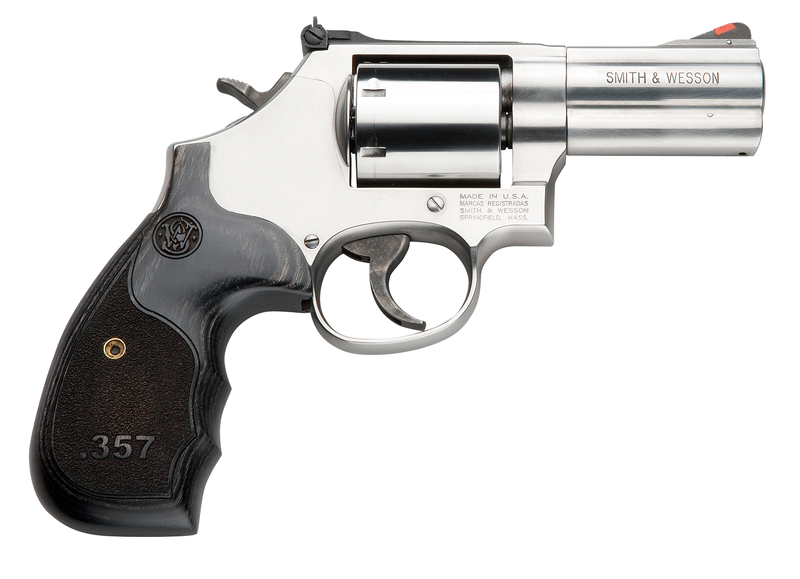

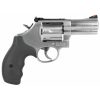

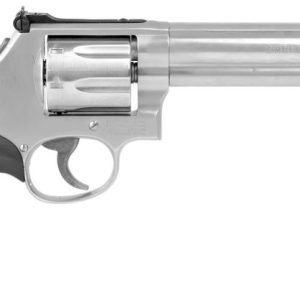

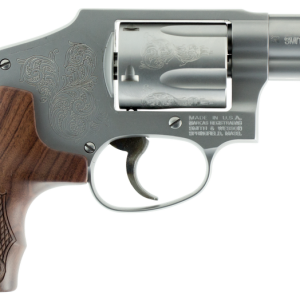
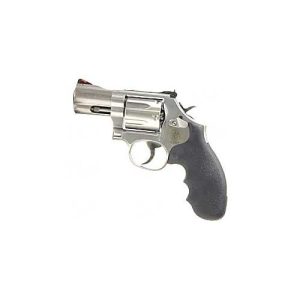


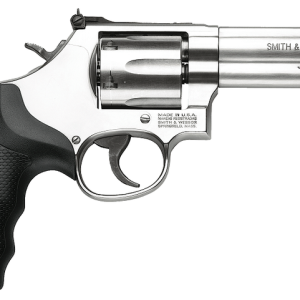
Reviews
There are no reviews yet.